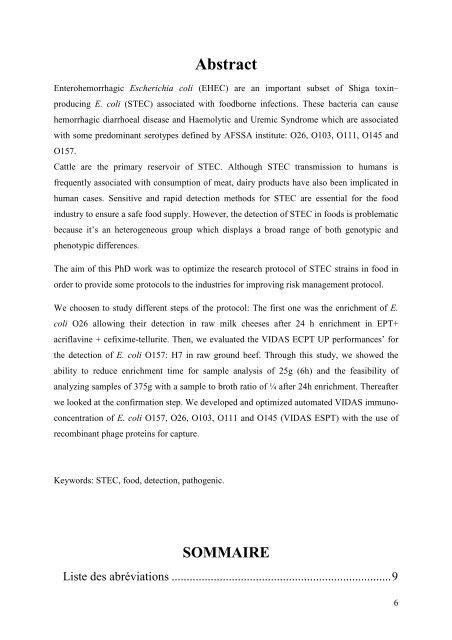CHAPITRE 1 - Université de Bourgogne
CHAPITRE 1 - Université de Bourgogne
CHAPITRE 1 - Université de Bourgogne
You also want an ePaper? Increase the reach of your titles
YUMPU automatically turns print PDFs into web optimized ePapers that Google loves.
Abstract<br />
Enterohemorrhagic Escherichia coli (EHEC) are an important subset of Shiga toxin–<br />
producing E. coli (STEC) associated with foodborne infections. These bacteria can cause<br />
hemorrhagic diarrhoeal disease and Haemolytic and Uremic Syndrome which are associated<br />
with some predominant serotypes <strong>de</strong>fined by AFSSA institute: O26, O103, O111, O145 and<br />
O157.<br />
Cattle are the primary reservoir of STEC. Although STEC transmission to humans is<br />
frequently associated with consumption of meat, dairy products have also been implicated in<br />
human cases. Sensitive and rapid <strong>de</strong>tection methods for STEC are essential for the food<br />
industry to ensure a safe food supply. However, the <strong>de</strong>tection of STEC in foods is problematic<br />
because it’s an heterogeneous group which displays a broad range of both genotypic and<br />
phenotypic differences.<br />
The aim of this PhD work was to optimize the research protocol of STEC strains in food in<br />
or<strong>de</strong>r to provi<strong>de</strong> some protocols to the industries for improving risk management protocol.<br />
We choosen to study different steps of the protocol: The first one was the enrichment of E.<br />
coli O26 allowing their <strong>de</strong>tection in raw milk cheeses after 24 h enrichment in EPT+<br />
acriflavine + cefixime-tellurite. Then, we evaluated the VIDAS ECPT UP performances’ for<br />
the <strong>de</strong>tection of E. coli O157: H7 in raw ground beef. Through this study, we showed the<br />
ability to reduce enrichment time for sample analysis of 25g (6h) and the feasibility of<br />
analyzing samples of 375g with a sample to broth ratio of ¼ after 24h enrichment. Thereafter<br />
we looked at the confirmation step. We <strong>de</strong>veloped and optimized automated VIDAS immuno-<br />
concentration of E. coli O157, O26, O103, O111 and O145 (VIDAS ESPT) with the use of<br />
recombinant phage proteins for capture.<br />
Keywords: STEC, food, <strong>de</strong>tection, pathogenic.<br />
SOMMAIRE<br />
Liste <strong>de</strong>s abréviations .........................................................................9<br />
6

















